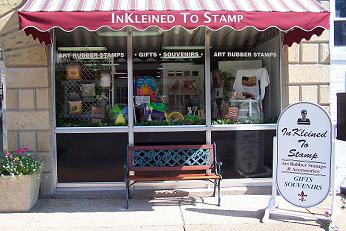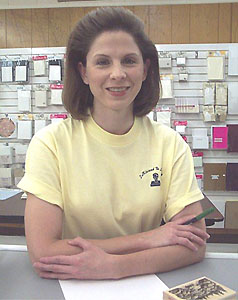
With the viewing of just one of her scenes I could see that this artist was not only fluent and accomplished in the visual language but also very much connected with the subject matter. Fluency with not only a given medium but with the foundational building blocks of visuals --composition, color, shape, value, intensity, etc.-- can allow one the freedom to concentrate on the moments within a process of expression. Pam Klein's pieces are so fluid that the emotional content and serenity of the pieces make you unaware, at first, of the complexity upon with which they are built. In many situations I have to really stop and think of what design she's using as it's commonly in a manner or angle that I haven't seen before. The sophisticated compositional structures and the planning involved (the logical --left brain) are in balance with these feelings they emit (creative/emotional --right brain). As you read Pam's words, it's so clear to see how deep her love of the outdoors goes. It's interwoven into her being and she translates these feelings so well into her work. I hope you enjoy the article.
KN: Why don't you give us a little background on yourself Pam. Where did you grow up? Where have you lived? Family? etc.

PK: I have lived in Ste. Genevieve, Missouri all of my life. In fact I am living in the same house that I was raised in! My parents divorced after my husband, Ron, and I had been married for two years, so we bought the house from them. It does look quite a bit different now, though. We have made a lot of changes to it. We have been married for twenty-one years and have two daughters. Taylor is thirteen and Ally is nine.
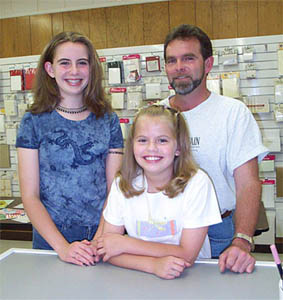
KN: What is your creative background? Arts, crafts, music, writing, hobbies in general.
PK: The only art training that I had was in school. I was fortunate to have two very good art teachers in junior and senior high school, but art has been a part of my life as far back as I can remember. From my early childhood up through high school my family lived next door to a couple that were very much involved in art. They were sculptors and painters and were always patient in letting me "play" in their studio and try my hand at their art. I was always making or drawing something as a child and as I grew older I tried my hand at several mediums. I've dabbled in oil painting, watercolor painting, pen & ink drawings, sculpture, sewing, macrame' (I'm dating myself here, but I was very into macrame' in the late 70's and early 80's!), counted cross-stitch, quilting and, of course, rubber stamping. I see so much of that in my daughters now. They always have some kind of project going. As far as music, I can't read it and couldn't carry a tune if my life depended on it! Running a stamp store doesn't allow a lot of time for hobbies, but I do enjoy collecting antiques. I haven't been able to attend any of the local antique auctions in years with having the business, but that has been a favorite pastime. The largest antique that we own is a circa 1800 vertical log cabin next to our home that my husband is just completing restoration on.
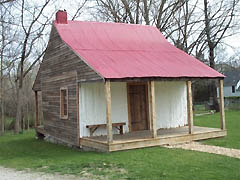
I love going to movies, but there is not much time for that any more. In what little "spare" time I do have, I enjoy cycling, Tae-Bo, and hiking. My goal is to spend my retirement years hiking in the Rockies, so I try to stay in shape!

KN: When did you first get into rubber stamping and how were you introduced to it?
PK: While on vacation during the summer of '94, Ron and I took the girls into a rubber stamp store so they could buy a souvenir from our trip. That was the first time that I had seen embossing and was fascinated by it. Needless to say, I spent more time in that store than anyone else!
KN: What was it about rubber stamping that you liked and what was it about the medium that brought you to open your store? When was your business established? Had you owned a business previous to InKleined to Stamp?
PK: What I really liked about the rubber stamping was how fast a project could be completed. Compared to other arts or crafts, like painting, quilting or counted cross-stitch, where a project can take days, weeks or even months to complete, rubber stamping provided immediate gratification. That, and I could see the potential for anyone to be able to do it. It was obvious that you didn't need to be able to draw to stamp, so the ability to create was there for anyone that wanted to try it. I have several customers that have said they don't have a creative bone in their body, but they love being able to stamp. On the flip side, if a person does have some creative ability they can take this art form as far as they want to. My business was started in early 1995, so obviously I got hooked fast. I started stamping then began selling stamps all within eight months. My feeling about opening a store was that I really had nothing to lose. I had been a stay-at-home mom for almost five years, so it wasn't like I was risking some high salary job to try this thing out! It was getting close to my youngest daughter starting school, so I knew I would have to get back to work and I didn't want to go back to what I was doing before. Before staying at home I had an upholstery business for several years, so in a way I knew what I was in for. Many people go into a business thinking that being self-employed will be easy and are totally unprepared and shocked at how much work it actually is. I love being self-employed, even with all the hours and all the different "hats" one has to wear.
KN: Tell us about your store Pam. What do you offer there?
PK: My business is located within another store called "The Craft Depot", which is a gift shop that is owned by two other women. We are located in the heart of Ste.Genevieve's historic district. Ste. Genevieve is the oldest town west of the Mississippi River, founded in 1735, and is located about 60 miles south of St. Louis. Tourists from all over the world come here to see the town. Ste. Genevieve received a lot of attention on the national news during the summer of '93 because of its historical significance and the flood that was threatening the town. Although I do draw customers from St. Louis, southern Missouri, southern Illinois and locally, a lot of my business is dependent on the tourists. People come here to see the town and many times just happen to stumble across the store, so many of my customers are one-time customers, just visiting the area. Stampers are always surprised to find a stamp store in a town this size (pop. about 4500). I have what is probably considered a smaller store in the industry. I currently carry about 5000 stamps from 50 companies, plus paper and accessory companies. I do teach classes, but do more demoing than classes since the town is so small. If you'd ask my customers, they would probably say that my strong point is in my samples. That is what they seem to enjoy the most.
KN: What do you enjoy about your store? Where is it now compared to when you started? How many hours does it require/week from you (I don't know how store owners do it!)?
PK: The thing I like most about having the store is the contact with people. I could be selling stamps over the Net, but there is so much fun in being able to demo stamping to a beginner or talk stamping with an avid rubber stamper. To see the amazement and excitement in a beginner's eyes, or when showing a new technique to an experienced stamper, or to help someone out with problems they may be having is so rewarding and something that can not be done over the Internet. I started out in another woman's business with only three eighteen-inch shelves of stamps and it has grown from there. I am now in my fourth location and it has grown with each move. Hours can vary from week to week. Since I am in a shared business with two others, I don't have to be there every day. We take turns working and take care of each other's part of the store. Even though I am not at the store every day, this business does take a lot of time dedicated to it almost daily. Even on my days "off" I am usually working on placing orders, a newsletter, reading various stamping publications, making samples, working on classes, experimenting with new techniques, looking for new companies, pricing items and getting them out on the shelves, etc. All of this easily adds up to more than the average forty-hour week!
KN: Do you find you have any/much time to stamp?
PK: Not nearly as much as I'd like! I was warned before starting this business that I would never stamp again. While it's not quite that bad, I don't get to stamp much. January and February are good times for me to get some stamping done, since the store is closed on Tuesdays during those months. I try to get to the store then for some uninterrupted stamping time. I used to stamp birthday and anniversary cards for both sides of the family, plus friends, but I finally had to give it up. With all that stamping I was not getting any samples completed for the store, so I had to quit. I think they all understand that what little stamping time I do have has to be dedicated to the store. I do stamp my Christmas cards every year, but even that has gotten to be a strain. I send out sixty, and that can be very time consuming. This past year I resorted to a combination of stamping, photography and computer just to save time. It was that or not send any at all. I just couldn't bring myself to send store-bought cards!
KN: I've just come to know your stamping works through the scenes in which you've used the Stampscapes line. I find them to be amazing works in every way that you could break them down --surface quality, composition, and emotional content. Starting with the surface and media I was wondering if you could tell us about your color application. You've really mastered the usage of the Tonal Applicator.
PK: The key to the Tonal Applicator (TA) is practice, practice, practice! Once you've got it down the trick is definitely taking your time. You can't get in a hurry when layering in the colors, especially the first one. I use several layers of color. On the blue scenes I've used as many as five shades of blue plus a black to layer in the color.
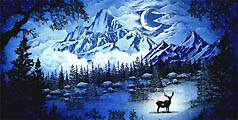
The first color can seem like it takes a long time to do, especially when the scenes are larger than postcard size, since it covers so much of the paper. The other colors then go on fairly quickly since I'm not covering as much area. I do a lot of tapping with the TA when it is very dry. Even with practically no ink on it at all I keep tapping, as it seems to help blend the colors. I find that the tapping of the TA is a great stress reliever! When it comes to composition and color, some of that just comes naturally. Having an eye for color and composition can, to a certain extent, be learned but for some it is a gift. Just as some people are born with a beautiful voice, or a natural rhythm to dance or play music, others are born with different talents. I'm one of the lucky ones to have been given this eye for color and composition. My mom says that I've always had it. If there is an emotional content to any of my scenes I have to credit that to my sheer love of the mountains and outdoors in general. I think that is what comes through the most in my scenes.
KN: In your scenes I've seen some very elaborate and fairly complicated compositions. While complicated, they pull together beautifully and don't read as tedious constructions but as a very cohesive whole. With the masking and layering, I'm guessing, these involve much planning. Is this the case? What is your approach and process to scene building? Do you work through roughs before working on a final piece? What is the relationship between your initial concept to the final result?
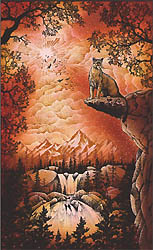
PK: I do plan out my scenes ahead of time, usually stamping them out on scrap paper just to see if it is going to look as good on paper as I had envisioned in my mind. They usually come together pretty quickly and then I'm ready to start on the glossy paper. Things slow down a little at this point. I am somewhat of a perfectionist (Can you hear my family laughing at the word "somewhat"?), so I like things placed just so in my compositions. In addition to a lot of masking I also use a stamp positioning tool with tracing paper. Having the images stamped out on the tracing paper allows me to move them around until I have them just where I want them, then I stamp. When I start a scene I have a picture in my mind of how I want it to look when it is finished, so I do have a goal that I am working towards. That's not to say that I won't change something part of the way into a scene, but I have a general idea of the direction I want things to go.
KN: Along the same lines as the previous question, in your scenes, many stamps are used. The compositions are larger requiring a given amount of images but I'm wondering if the process of arranging things is a source of enjoyment for you? Are you one that enjoys figuring out space and spacing, arranging things just right, maximizing?
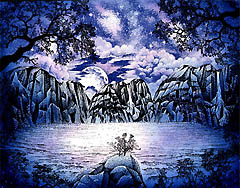
PK: Oh, yeah, I love arranging the stamps around to see how they will work in relation to each other. Even before I make my rough draft on scrap paper I will drag out all the Stampscapes stamps and move them around on the table like puzzle pieces to see what looks good together. I also like to use vacation photos, a book on RMNP (Rocky Mountain National Park), and also a favorite RMNP web site as inspiration for scenes. Then it becomes a challenge to find just the right stamps to try to create that scene on paper. I find it very hard to keep the scene scaled down to postcard size. Just as impossible as it is to capture the size, depth and beauty of the mountains in a photograph, so it is when I have these scenes in my head that I'm dying to get on paper. I can't fit it all in a smaller format. Whatever size it ends up being is fine. I get everything stamped, trim it where necessary and then start layering the color in with the TA.
KN: The lighting in your scenes is a very tranquil one. The mood (based on these three scenes) is very distinct. What is your personal esthetics as it relates to this certain quality? For example, does it relate to you favorite time of day? What are your thoughts on light, mood, or even color?
PK: I'm not sure that the tranquil lighting or mood was a conscious thing that I did, rather more of a reflection of the serenity and peace of mind that I find in the mountains. I think it naturally evolved as the scenes went along. I do favor the cooler colors, so even though I have done both, I prefer to use nighttime/moon scenes rather than daytime/sun scenes.

KN: Is there a certain time of the day that you tend to find yourself stamping? I'm guessing that as a store owner that answer might be "Whenever you happen to find any time at all" but I guess when would you be stamping if your time was free? Or is there even a specific time that you find your creativity flowing more than another? How do you like the experience to be? Do you prefer anything such as music playing, TV on, silence, solitude, etc?
PK: I really can't pinpoint a time of day that I find creating easier than another because its been so long since I've had any "free" time that I've forgotten if there is one! For now it's just whenever the mood strikes and if time allows. One thing that I can say is that when I get an idea in my head it drives me crazy until I can find time to get it down on paper! I do prefer being alone while I am working, but usually have the TV, radio or a cd on. If I have music playing I prefer classical. I'm not much of an opera fan, but I do like classical music.
KN: With the first scene that you sent, that's now posted in your gallery, you wrote: "Artists Note: Rocky Mountain National Park (RMNP) in Colorado is my favorite place on earth. Your "Tall Peak" stamp reminds me so much of Longs Peak, which is the focal point of RMNP. I created this on one of those days when I was especially missing the mountains, so for a title I think I'd have to call this "Hiking Is Life". Your scenes certainly do seem to have a strong connection with something. Tell us about your connection with Colorado, this park, or the outdoors in general.
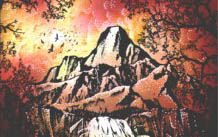
PK: My family always took vacations together and visited several states. One summer during high school we went to Colorado, and it's been a love affair for me ever since. Of all the areas that I have visited, the Estes Park/Rocky Mountain National Park area is my favorite. To me it is the closest thing to heaven on earth. In the first few years we were married Ron and I made a couple of trips out there. After we had the girls we had to keep our vacations a little closer to home, but since they are older they have made the trip with us each of the last four years. They have become quite the hikers! Last summer they logged 50 miles in a week with us in RMNP. My feelings about the Estes Park/RMNP area are kind of hard to explain. I just feel this draw towards the mountains. When I'm there it just feels right...like I'm at "home". There is just something so calming and humbling about being in the mountains.
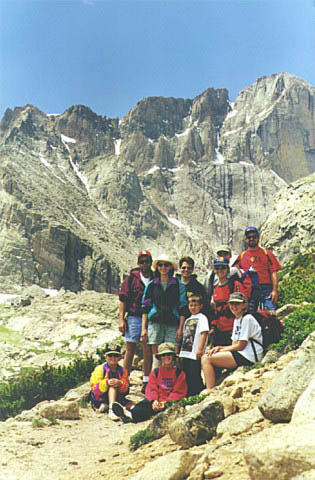
The Klein, Gegg and DeRousse families on the trail to Chasm Lake in Rocky Mountain National Park, July 1999
KN: We got into this in the previous question but to elaborate~ The creative process always seems pretty deeply interwoven with one's self. What does your art or the process of making your art do for you?
PK: Creating a piece of rubber stamped art, for me, is so relaxing, especially with the Stampscapes line. I remember reading in an issue of Somerset Studio that you draw the places that you want to be. That is what it is like for me as well. Stamping out these scenes is my way of taking a mini vacation to the place that I would rather be. The key to creating these scenes is the fact that I truly love the subject matter. When I was working on the "Hiking Is Life" scene I was so into it that I lost all track of time.
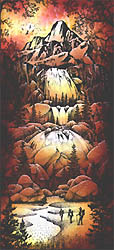
I honestly think the building around me could have collapsed and I wouldn't have noticed. When it was finished I looked at it and thought to myself "Did I do this?" It was like someone else had taken over and created it in my place.
KN: Is there anything you would like to mention that I might have missed?
PK: Here are a couple of quotes that I particularly like from some signs at scenic overlooks in Colorado that express what I feel but have so much trouble putting into words. Don't know if you have any use for them, but feel free to use them if you think they would be appropriate anywhere.
"Thousands of tired, nerve-shaken, over-civilized people are beginning to find out that going to the mountains is going home, that wilderness is a necessity" -John Muir (1838-1914)
"Without parks and outdoor life all that is best in civilization will be smothered. To save ourselves, to prevent our perishing, to enable us to live at our best and happiest, parks are necessary. Within National Parks is room -glorious room - room in which to find ourselves, in which to think and hope, to dream and plan, to rest and resolve." -Enos Mills (Founder of Rocky Mountain National Park)
I'd love to add photos of RMNP, but wouldn't know where to start! For photos of the park, Jesse Speer's web site just can't be beat. It's up to you whether or not you want to include a link to it.
Jesse Speer's Explore Rocky - http://www.estes-park.com/newpics/explore-rocky.html
KN note: I'd like to thank Pam for granting this interview and sharing her thoughts with us. I don't know about you but I feel like jumping in a plane and heading out to the Rocky Mountain National Park for a vacation! You paint a beautiful picture of your favorite place on earth. The expanses, tranquility, serenity, beauty, etc. ~a part of all of those things that draw us to the outdoors/mountains is something that are captured so nicely in your visuals/visions. Thank you Pam.
InKleined To Stamp
Store Closed
